Regions
Western Lechtal Alps, Western Verwall Mountains, Silvretta
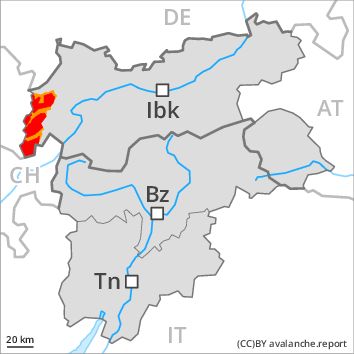
Danger level
Danger Level 4 - High above 2000m
Danger Level 3 - Considerable above 2000m
Avalanche Problem
Wind-drifted snow above 2000m, N-NE-E-SE-S-SW-W-NW
Wet snow, N-NE-E-SE-S-SW-W-NW

The snow sport conditions outside marked and open pistes are dangerous. High, level 4. More frequent natural avalanches are to be expected.
The snow sport conditions outside marked and open pistes are dangerous. Single winter sport participants can release avalanches very easily, including large ones. This applies in particular above approximately 2000 m in all aspects. As a consequence of warming during the day and the solar radiation, the likelihood of slab avalanches being released will increase appreciably on steep sunny slopes.
As the day progresses more natural moist avalanches are to be expected. This applies in particular on very steep sunny slopes. The avalanches can be released in the various layers of fresh snow and reach large size in isolated cases. Snow sport activities outside marked and open pistes call for very extensive experience in the assessment of avalanche danger and great restraint.
Snowpack
dp 6: cold, loose snow and wind
dp 10: springtime scenario
30 to 50 cm of snow, and even more in some localities, fell. This applies above approximately 2000 m. At low and intermediate altitudes the snow is moist. The sometimes strong wind will transport the fresh snow. Over a wide area fresh snow and wind slabs are lying on soft layers. This applies in all aspects above approximately 2000 m. The older wind slabs have bonded quite well with the old snowpack. In very isolated cases weak layers exist in the old snowpack, in particular in areas where the snow cover is rather shallow.
Tendency
The avalanche danger will decrease.
Regions
Val Müstair Alps, Langtaufers, Ortler Range, Schnals Ridge
AM
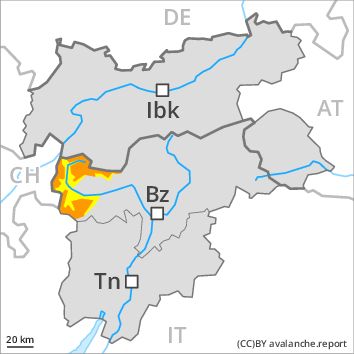
Danger level
Danger Level 3 - Considerable above 2200m
Danger Level 2 - Moderate above 2200m
Avalanche Problem
Wind-drifted snow above 2200m, N-NE-E-SE-S-NW
Wet snow above 2200m, N-NE-E-SE-S-SW-W-NW
PM
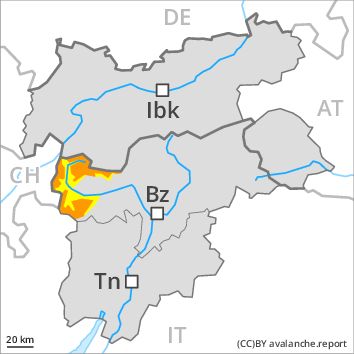
Danger level
Danger Level 3 - Considerable above 2200m
Danger Level 2 - Moderate above 2200m
Avalanche Problem
Wet snow above 2200m, N-NE-E-SE-S-SW-W-NW
Wind-drifted snow above 2200m, N-NE-E-SE-S-NW
As a consequence of warming there will be an increase in the danger.
As a consequence of fresh snow and a sometimes strong wind from northerly directions, extensive wind slabs formed. This applies in particular on very steep shady slopes and adjacent to ridgelines as well as at high altitudes and in high Alpine regions. In some cases avalanches are medium-sized and can be released even by a single winter sport participant.
The danger of moist and wet avalanches will already exist in the early morning. As a consequence of warming during the day and the solar radiation, the likelihood of moist and wet avalanches being released will increase appreciably in all aspects. In addition as the day progresses small and medium-sized moist loose snow avalanches are to be expected. Avalanches can in isolated cases be triggered in the old snowpack and reach large size. On rocky sunny slopes the avalanche prone locations are more prevalent.
Snowpack
dp 6: cold, loose snow and wind
dp 3: rain
15 to 25 cm of snow. will fall until the early morning. The sometimes strong wind will transport the fresh snow. In some places fresh snow and wind slabs are lying on soft layers. The fresh and somewhat older wind slabs are in some cases prone to triggering, especially on shady slopes above approximately 2200 m. The older wind slabs have bonded well with the old snowpack.
The surface of the snowpack will cool hardly at all during the overcast night and will already be soft in the early morning.
Tendency
As a consequence of warming during the day and solar radiation there will be an increase in the danger.
Regions
Weißkugel Range, Gurgler Range, Central Stubai Alps, Eastern Verwall Mountains, Northern Zillertal Alps, Allgäu Alps, Venediger Range, Samnaun Mountains, Eastern Lechtal Alps - Ammergau Alps, Northern Oetz and Stubai Alps, Mieming Mountains, Western Tuxer Alps, Karwendel Mountains, Eastern Tuxer Alps, Brandenberg Alps, Western Kitzbühel Alps, Wilder Kaiser Mountains - Waidring Alps, Eastern Kitzbühel Alps, Central Lechtal Alps, Glockturm Range, Grieskogel Mountains

Danger level
Danger Level 3 - Considerable above 1500m
Danger Level 2 - Moderate above 1500m
Avalanche Problem
Wind-drifted snow above the treeline, N-NE-E-SE-S-SW-W-NW
Wet snow, N-NE-E-SE-S-SW-W-NW

The snow sport conditions outside marked and open pistes are to some extent precarious. More frequent natural avalanches are to be expected.
The snow sport conditions outside marked and open pistes are to some extent precarious. Single winter sport participants can release avalanches easily, including medium-sized ones. This applies on steep slopes above the tree line. As a consequence of warming during the day and the solar radiation, the likelihood of slab avalanches being released will increase appreciably on steep sunny slopes.
As the day progresses a large number of small and, in isolated cases, medium-sized natural moist avalanches are to be expected. The avalanches are shallow. Snow sport activities outside marked and open pistes call for extensive experience in the assessment of avalanche danger and caution.
Snowpack
dp 6: cold, loose snow and wind
dp 10: springtime scenario
10 to 30 cm of snow, and even more in some localities, fell. This applies above approximately 2000 m. Up to intermediate altitudes rain has fallen. At low and intermediate altitudes the snow is moist. The sometimes strong wind will transport the fresh snow. Over a wide area fresh snow and wind slabs are lying on soft layers. This applies in all aspects above the tree line. The older wind slabs have bonded quite well with the old snowpack. In very isolated cases weak layers exist in the old snowpack, in particular in areas where the snow cover is rather shallow.
Tendency
The avalanche danger will persist.
Regions
Texel Mountains, Durreck Range, Western Rieserferner Mountains, Southern Stubai Alps, Southern Zillertal Alps and High Tauern, Saldurn-Mastaun Ridge

Danger level
Danger Level 2 - Moderate
Avalanche Problem
Wind-drifted snow above 2200m, N-NE-E-SE-NW
Wet snow above 2200m, N-NE-E-SE-S-SW-W-NW

As a consequence of warming there will be an increase in the danger.
As a consequence of fresh snow and a sometimes strong wind from northerly directions, mostly small wind slabs formed. This applies in particular on very steep shady slopes and adjacent to ridgelines at high altitudes and in high Alpine regions. In some cases avalanches are medium-sized and can be released in some cases by a single winter sport participant.
The danger of moist and wet avalanches will already exist in the early morning. As a consequence of warming during the day and the solar radiation, the likelihood of moist and wet avalanches being released will increase appreciably in all aspects. In addition as the day progresses small and medium-sized moist loose snow avalanches are to be expected. Avalanches can in isolated cases be triggered in the old snowpack and reach large size. On rocky sunny slopes the avalanche prone locations are more prevalent.
In places where more snow falls the avalanche danger is greater.
Snowpack
dp 6: cold, loose snow and wind
dp 3: rain
10 to 20 cm of snow, and even more in some localities, will fall until the early morning. The sometimes strong wind will transport the fresh snow. In some places fresh snow and wind slabs are lying on soft layers. The fresh and somewhat older wind slabs are in some cases prone to triggering, especially on shady slopes above approximately 2200 m. The older wind slabs have bonded well with the old snowpack.
The surface of the snowpack will cool hardly at all during the overcast night and will already be soft in the early morning.
Tendency
As a consequence of warming during the day and solar radiation there will be an increase in the danger.
Regions
Glockner Range, Eastern Deferegger Alps, Schober Mountains, Lienzer Dolomites, Eastern Rieserferner Mountains
AM

Danger level
Danger Level 2 - Moderate above 2200m
Danger Level 1 - Low above 2200m
Avalanche Problem
Wind-drifted snow above 2200m, N-NE-E-NW
PM
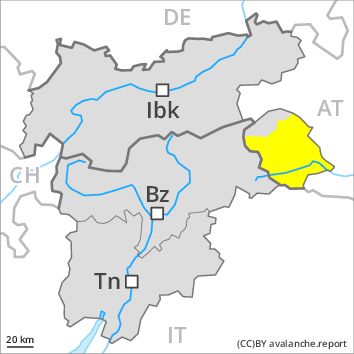
Danger level
Danger Level 2 - Moderate above 2200m
Danger Level 2 - Moderate above 2200m
Avalanche Problem
Wind-drifted snow above 2200m, N-NE-E-NW
Wet snow, E-SE-S-SW-W
Fresh wind slabs require caution, especially above approximately 2200 m adjacent to ridgelines. As a consequence of warming during the day and solar radiation mostly small moist avalanches are to be expected.
As a consequence of a sometimes strong wind, mostly small wind slabs formed. Caution is to be exercised in particular on very steep slopes above approximately 2200 m adjacent to ridgelines. Single winter sport participants can release avalanches. The avalanches are rather small.
As the day progresses as a consequence of warming there will be a gradual increase in the danger of moist and wet avalanches. This applies in particular on steep sunny slopes.
Snowpack
dp 6: cold, loose snow and wind
dp 10: springtime scenario
The sometimes strong wind will transport the fresh snow. In some places fresh snow and wind slabs are lying on soft layers, especially on shady slopes above approximately 2200 m. The older wind slabs have bonded well with the old snowpack. In very isolated cases weak layers exist in the old snowpack on shady slopes, in particular in areas where the snow cover is rather shallow.
Tendency
As a consequence of warming, the likelihood of moist and wet avalanches being released will increase.
Regions
Latemar, Southern Adamello, Primiero - Pale di S. Martino, Adamello - Presanella, Northern Brenta - Peller, Western Nonsberg Alps, Southern Brenta, Fassa Valley, Sole, Pejo and Rabbi, Southern Lagorai, Northern Lagorai, Maddalene, Paganella, Pine' - Mocheni Valley
AM
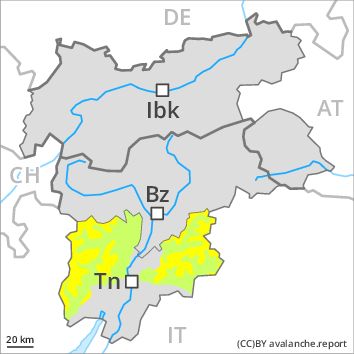
Danger level
Danger Level 2 - Moderate above 2200m
Danger Level 1 - Low above 2200m
Avalanche Problem
Wet snow above 2200m, N-NE-E-SE-S-SW-W-NW
Persistent weak layer above 2400m, N-NE-NW
PM
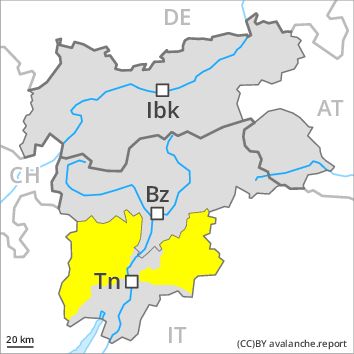
Danger level
Danger Level 2 - Moderate above 2200m
Danger Level 2 - Moderate above 2200m
Avalanche Problem
Wet snow above 2400m, N-NE-E-SE-S-SW-W-NW
Persistent weak layer above 2400m, N-NE-NW
The danger of moist and wet avalanches will increase during the day.
Especially on rocky sunny slopes and on wind-loaded slopes numerous small to medium-sized natural wet avalanches are to be expected as a consequence of warming. The danger of wet and gliding avalanches will increase during the day. Weak layers exist in the snowpack in particular on wind-loaded slopes. This applies on steep northeast, north and northwest facing slopes above approximately 2400 m adjacent to ridgelines. These avalanche prone locations are difficult to recognise. The sometimes fresh snow-covered wind slabs are to be evaluated with care and prudence in particular in very steep terrain. In the regions exposed to heavier precipitation the avalanche prone locations are more prevalent and larger. As a consequence of warming, the likelihood of moist and wet avalanches being released will increase gradually in particular on steep slopes at intermediate altitudes.
Snowpack
The older wind slabs have bonded well with the old snowpack. In very isolated cases weak layers exist in the old snowpack on shady slopes, in particular in areas where the snow cover is rather shallow. In some places wind slabs are lying on soft layers, in particular on shady slopes above approximately 2400 m. At low altitude a little snow is lying.
Tendency
Gradual increase in avalanche danger as a consequence of warming during the day and solar radiation.
Regions
Gröden Dolomites, Prags Dolomites, Sarntal Alps, Western Pfunderer Mountains, Sexten Dolomites, Eastern Pfunderer Mountains, Western Deferegger Alps, Ulten Valley, Eastern Nonsberger Alps, Northern Dolomites of Fiemme
AM

Danger level
Danger Level 2 - Moderate above 2200m
Danger Level 1 - Low above 2200m
Avalanche Problem
Persistent weak layer above 2400m, N-NE-NW
Wet snow above 2200m, N-NE-E-SE-S-SW-W-NW
PM

Danger level
Danger Level 2 - Moderate above 2200m
Danger Level 2 - Moderate above 2200m
Avalanche Problem
Wet snow above 2400m, N-NE-E-SE-S-SW-W-NW
Persistent weak layer above 2400m, N-NE-NW
Wet snow requires caution.
The avalanches can be released, in particular by large loads. They can in isolated cases be released in the old snowpack. As a consequence of fresh snow and a sometimes strong wind from northerly directions, mostly small wind slabs formed in the last two days. As the day progresses as a consequence of warming there will be a gradual increase in the danger of moist and wet avalanches. These avalanche prone locations are rather rare and are clearly recognisable to the trained eye.
Snowpack
dp 6: cold, loose snow and wind
Faceted weak layers exist in the snowpack especially on steep, little used shady slopes. The sometimes strong wind has transported the fresh snow and, in some cases, old snow as well. Outgoing longwave radiation during the night will be quite good over a wide area. A clear night will be followed by quite favourable conditions for a short time, but the danger of wet avalanches will increase later.
Tendency
As a consequence of warming during the day and solar radiation there will be an increase in the danger.
Regions
Prealps, Cembra Valley, Bondone and Stivo, Vallarsa, Folgaria - Laverone, Ledro Valley, Marzola - Valsugana
AM
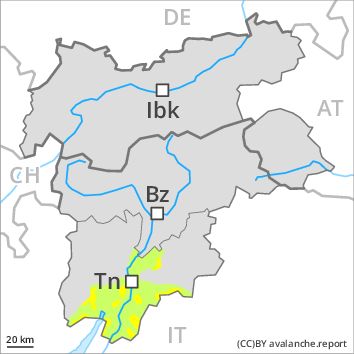
Danger level
Danger Level 2 - Moderate above the treeline
Danger Level 1 - Low above the treeline
Avalanche Problem
Wind-drifted snow above the treeline, N-NE-E-SE-S-SW-W-NW
PM
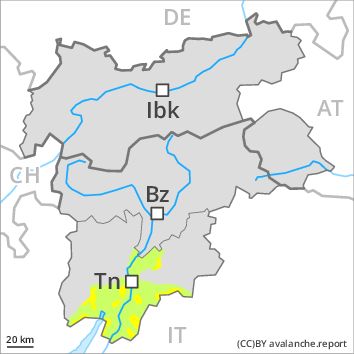
Danger level
Danger Level 2 - Moderate above the treeline
Danger Level 1 - Low above the treeline
Avalanche Problem
Wet snow above the treeline, N-NE-E-SE-S-SW-W-NW
Gliding snow above the treeline, N-NE-E-SE-S-SW-W-NW
As a consequence of fresh snow and heat an unfavourable avalanche situation will persist in some regions.
The surface of the snowpack will freeze to form a strong crust only at high altitudes and will soften quickly. The danger of wet and gliding avalanches will increase but remain within the current danger level. As a consequence of warming during the day and the solar radiation, the likelihood of moist and wet avalanches being released will increase gradually in particular on rocky slopes at intermediate and high altitudes. In particular on steep sunny slopes and on wind-loaded slopes more frequent small to medium-sized moist avalanches are possible until the temperature drops.
Snowpack
dp 2: gliding snow
In some places fresh snow and wind slabs are lying on old snow containing large grains. This applies in particular on shady slopes at high altitudes and in high Alpine regions. The old snowpack will be subject to considerable local variations at low and intermediate altitudes. At low altitude no snow is lying on south facing slopes.
Tendency
Gradual increase in avalanche danger as a consequence of warming during the day and solar radiation.













